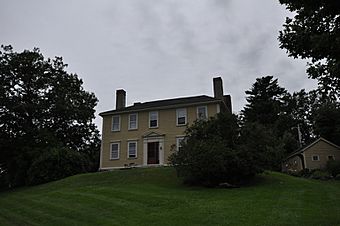Stroudwater Historic District facts for kids
Quick facts for kids |
|
|
Stroudwater Historic District
|
|

The Means House, which stands opposite the Tate House
|
|
| Location | Confluence of Stroudwater and Fore Rivers, Portland, Maine |
|---|---|
| Area | 115 acres (47 ha) |
| Built | 1727 |
| Architectural style | Greek Revival, Mixed |
| NRHP reference No. | 73000126 |
| Added to NRHP | February 16, 1973 |
The Stroudwater Historic District is a special area in the Stroudwater neighborhood of Portland, Maine. It's like a preserved piece of history! This district was once a very important village. People built ships and ran mills here. Thomas Westbrook started this settlement way back in 1727. This historic area was added to the National Register of Historic Places in 1973.
Contents
What is the Stroudwater Historic District?
The Stroudwater Historic District is located in Portland, Maine. It sits where the Stroudwater River meets the Fore River. This area is shaped a bit like a triangle. It has many old houses from the late 1700s and early 1800s.
Historic Buildings and Sites
You can find one of Portland's oldest cemeteries here. The first marked grave dates back to 1739. The famous Tate House is also in this district. It was built in 1755. This house is so important, it's a National Historic Landmark. It belonged to a man who supplied large wooden masts for the king's ships.
The district also has homes from the mid-1800s. You can see parts of the old Cumberland and Oxford Canal. There are even hidden remains of early factories.
A Look Back: Stroudwater's History
Europeans first settled the Stroudwater area in the 1600s. They built a sawmill near the Stroudwater falls. However, this first settlement was abandoned. This happened in the 1680s due to conflicts with local Native Americans.
Colonel Westbrook's Village
In 1727, Colonel Thomas Westbrook resettled the area. He was hired by King George II. His job was to find and prepare large trees. These trees were used as masts for the king's ships. Colonel Westbrook built some of the first roads here. This helped move the huge masts to the river for shipping.
He also built a dam and a bridge over the river. He set up sawmills and gristmills. This made Stroudwater an early industrial village. Business was very good for many years.
Changes Over Time
Trade slowed down a lot in the early 1800s. This was because of the Embargo Act of 1807 and the War of 1812. But things picked up again with the Cumberland and Oxford Canal. This canal helped transport goods.
Later, railroads became more important than canals. A railroad bridge was built. This bridge cut off the area's wharves. It also separated the shipbuilding spots from the main harbor. Since then, Stroudwater has mostly become a quiet neighborhood. It is now a place where people live.



